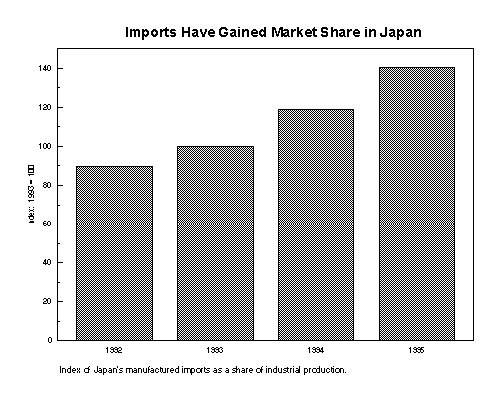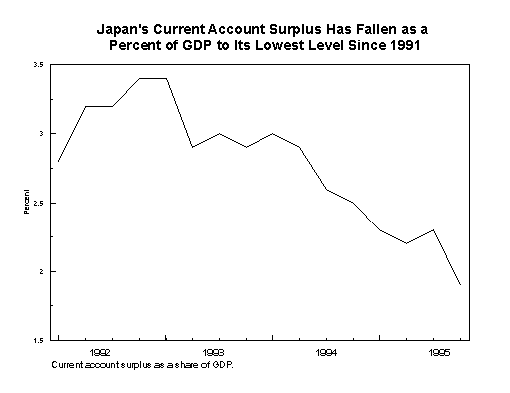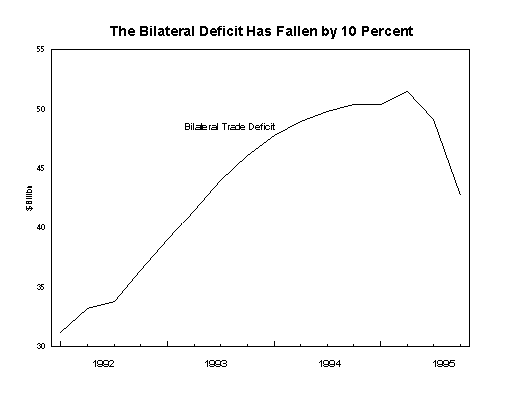         |
U.S. TRADE POLICY WITH JAPAN:
ASSESSING THE RECORD
An Update
The Council of Economic Advisers
and
U.S. Treasury Department
April 12, 1996
President Clinton has made opening the Japanese market a key
priority.
One month after taking office, President Clinton set forth a
simple but powerful mission statement to guide trade policy: "We
must compete, not retreat." At the same time, he made clear that
his trade policy would not be business as usual. "We will
continue to welcome foreign products and services into our
markets but insist that our products and services be able to
enter theirs on equal terms." Since that time, President Clinton
has been unwavering in his commitment to secure tough but fair
trade agreements -- and to make sure that those agreements are
enforced.
President Clinton has made the economic relationship with
Japan a model for his distinctive approach to trade policy.
Accordingly, one of his first trade initiatives was to establish
a "framework for a new trade relationship with Japan." In the 33
months since the Framework Agreement was signed, the
Administration has concluded more trade agreements with Japan
than any previous administration. And in keeping with the
President's commitment to America's companies, workers and
farmers, the Administration has followed through on implementing,
reviewing, and enforcing these agreements. The President's
consistent application of the principles he laid out in his first
months in office is now producing convincing results.
U.S. exports to Japan in targeted sectors are growing rapidly.
The Clinton Administration has negotiated 20 trade
agreements with Japan, including Uruguay Round, Framework, and
other bilateral agreements. The agreements cover priority areas
from general market access and deregulation, to intellectual
property rights protection for U.S. goods and services, to
important services sectors such as insurance and construction, to
specific goods sectors such as automobiles and apples. The trade
agreements are "win-win", yielding lower prices and higher
quality for Japanese purchasers and consumers and increasing
market access for U.S. companies, workers and farmers. Free and
fair trade has long been recognized as the basis for increasing
living standards for all trading partners.
The Administration's strategy is results-oriented. The
agreements include objective criteria for measuring progress and
timelines for review of the agreements. The Administration has
placed a high priority on enforcing the agreements, which is
helping to ensure they deliver real benefits for American
companies, workers, and farmers.
The Administration's strategy is showing positive results.
In the goods sectors covered by our Uruguay Round, Framework, and
other bilateral agreements, U.S. exports to Japan have grown over
85 percent since this Administration took office. Growth in
exports to Japan in these sectors is 3 times greater than growth
in other U.S. exports to Japan -- which has also been strong.
Indeed, growth in all U.S. exports to Japan of 34 percent has
been over twice as great as growth in U.S. exports to the
European Union. Total U.S. exports to Japan reached a record $64
billion in 1995.
The July 1993 Framework Agreement is the cornerstone of the
Administration's trade policy with Japan. The Framework focuses
on all three aspects of the economic relationship with Japan--
macroeconomic, structural and sectoral--and it establishes
guidelines for review of the agreements to ensure that the
desired results are achieved. This strategy is now paying off:
in the goods sectors covered by the Framework Agreement alone,
U.S. exports to Japan have risen 120 percent since the Agreement
was signed -- four times as fast as other U.S. exports to Japan.
U.S. businesses and workers are achieving successes in sectors
covered by Clinton Administration trade agreements.
Autos and Auto Parts: Since the auto and auto parts agreement
was signed in August 1995, U.S. auto and auto parts exports to
Japan have risen over 35 percent, totalling $3.8 billion in 1995
-- already exceeding exports to the European Union. In 1995, the
Big Three and Japanese transplant producers exported over 140,000
U.S.-made vehicles to Japan, up nearly 40 percent from 1994.
Recognizing that U.S. auto makers could expand their sales if
given adequate opportunity to display their products in Japan,
the Administration targeted access to dealerships as an important
part of the August 1995 auto and auto parts agreement. Since the
agreement was signed, the Big Three U.S. automakers have added 30
high-quality, high-volume dealer outlets in Japan, but more
progress is required.
Deregulatory actions in Japan are beginning to lead to more sales
for competitive U.S. suppliers in the auto parts aftermarket.
U.S. parts suppliers will now have the opportunity to sell their
products through Japan's major auto parts retailers and service
stations. Such access will dramatically increase U.S. auto parts
sales to Japan: For example, as result of opportunities created
by the agreement, Tenneco Automotive, which has made efforts to
break into this market for years, expects to expand its sales of
shocks and struts in Japan from the existing level of 70,000 units per
year to 105,000 in 1996.
Telecommunications Equipment: Since two agreements on
telecommunications procurement were signed on November 1, 1994,
U.S. exports of telecommunications equipment to Japan have
increased nearly 50 percent, to $1.7 billion in 1995. This is
almost twice as fast as the growth of U.S. exports of
telecommunications equipment to the European Union, albeit
starting from a lower base.
Cellular Telephones: After years of stalled negotiations, the
Clinton Administration concluded an agreement in March 1994 with
Japan to open the cellular telephone market in the Tokyo-Nagoya
area, the largest population center in Japan. Since the
agreement was signed and the Japanese Government instituted
deregulation measures, subscribers to the North American designed
system have grown from 22,000 to 600,000. Motorola, which tried
unsuccessfully for years to break into this market, provides the
bulk of the equipment to build and maintain this system, with
sales values in the hundreds of millions of dollars per year.
Greater competition in the region has also benefitted Japanese
consumers -- they now not only have greater choice but also enjoy
lower prices for cellular phone services. Initiation and monthly
service fees are now one-third the previous rates.
Medical Technology: The Clinton Administration concluded a
Framework Agreement with Japan covering public sector procurement
of medical technology (such as MRI machines and CT scanners) on
November 1, 1994. A review of the agreement in July 1995
determined that the Japanese Government has made good progress
toward implementing the transparent and open procurement
procedures called for in the agreement. Since the agreement was
signed, U.S. exports of medical technology to Japan have increased over
35 percent, to nearly $2 billion in 1995.
Rice: The Clinton Administration targeted rice in the Uruguay
Round negotiations. Although American medium-grain rice has been
highly rated on quality by the Japanese Food Agency, imported rice was
virtually banned in Japan for decades. With the successful conclusion of
the Uruguay Round, Japan finally opened its market to imported rice and
American rice has been well-received by Japanese consumers.
In 1993, a major failure of the rice crop in Japan led to the
first taste of American rice for many Japanese consumers. Since
that time, U.S. farmers have sold $287 million of rice exports to
Japan, more than the previous 25 years combined. And although
Japan's rice crop subsequently recovered, U.S. exports of rice to
Japan in 1995 totalled $31 million.
Apples: The Clinton Administration targeted apples as one of its
first bilateral trade initiatives with Japan, and an agreement
was concluded on September 13, 1993. Since that time, the
Administration has continued to work with Japanese officials to
increase the number of U.S. apple growers and apple varieties
certified to supply the Japanese market. These sustained efforts
are beginning to pay off: where U.S. apple exports to Japan were
once banned, apple exports approached $7 million in 1995.
Meanwhile, imports of apples have brought lower prices to
Japanese consumers, which will help increase overall apple sales
in Japan.
Copper: The Clinton Administration targeted copper in the
Uruguay Round negotiations. Since the Uruguay Round Agreement
was signed, U.S. exports of copper to Japan have increased by
over 80 percent, to $350 million in 1995. The United States
sells 1.5 times as much copper to Japan as to the European Union,
and U.S. exports of copper to Japan are growing faster than those
to the European Union.
Chemicals: The Clinton Administration targeted chemicals in the
Uruguay Round negotiations. Since the Uruguay Round Agreement was
signed, U.S. exports of chemicals to Japan have grown nearly
25 percent, reaching $2.8 billion in 1995.
Flat Glass: Until the flat glass agreement was signed in January
1995, Japan's $4.5 billion market for flat glass had been
dominated by an oligopoly of 3 Japanese producers. U.S. exports
of flat glass to Japan doubled in 1995 to nearly 5 million square
meters.
Japan's market is also opening up more broadly.
Realizing that progress in individual sectors would depend
in part on addressing overall imbalances, the Administration
targeted macroeconomic and structural adjustment in Japan as
important aspects of the Framework agreement. On these fronts as
well, the results have been positive. Japan's imports have been
growing rapidly. This strong import growth is especially
encouraging given low overall growth in Japan and the recent
depreciation of the yen against the dollar. Indeed, recent
evidence suggests Japan may be experiencing a structural shift
towards greater acceptance of imports.
By the last quarter of 1995, the Japanese current account
surplus had fallen below 2 percent as a share of the economy.
Moreover, Consensus Economics forecasts continued reduction in
Japan's current account surplus from $110 billion in 1995 to $88
billion in 1996 and $69 billion in 1997.
And the bilateral trade deficit with Japan has begun to decline.
Despite slow growth in Japan during 1995, U.S. merchandise
exports to Japan grew five times faster than our imports from
Japan. Overall, U.S. merchandise exports to Japan grew 20
percent in 1995 alone. As a result, the trade deficit with Japan
declined by nearly 10 percent -- the first decline in five years.
Trade in autos accounted for half of the improvement in the trade
deficit: U.S. auto exports to Japan increased by nearly 40
percent while imports fell for the first time in a decade.
The improvement in the trade deficit in part reflects
economic recovery in Japan. While we welcome the improvement in
the bilateral deficit, it is important to note that the bilateral
deficit is not a scorecard for trade policy. The goal of our
trade policy is to improve the economic well-being of Americans
by expanding trade.
The recent success of our Japan trade policy parallels
improvement in overall U.S. competitiveness.
Our strong export performance in general and to Japan in
particular is attributable to a variety of factors, in addition
to the numerous market opening agreements concluded during this
Administration. The President's overall economic plan, with its
emphasis on deficit reduction and investment, has led to strong
sustained growth with low inflation. This has encouraged strong
growth in U.S. investment and employment, and helped to
strengthened U.S. business confidence and the fundamental
competitiveness of U.S. industries and workers. The economic
results have been impressive by any measure: during the last
three years, the American economy has produced 8.5 million new
jobs; the federal budget deficit has been cut nearly in half;
home ownership is at a 15-year high; the combined rate of
inflation and unemployment is the lowest in 27 years; and an all-
time high of almost 2 million new businesses have been created.
U.S. exports have surged, rising 31 percent since the beginning
of the Administration, and the World Economic Forum has ranked
the United States number one on competitiveness for two years in
a row, up from number 5 in 1992.
For more information, please contact Michele Jolin at 202-395-5084.
Charts




White Papers Index
President and First Lady | Vice President and Mrs. Gore
Record of Progress | The Briefing Room
Gateway to Government | Contacting the White House
White House for Kids | White House History
White House Tours | Help | Text Only Privacy Statement |